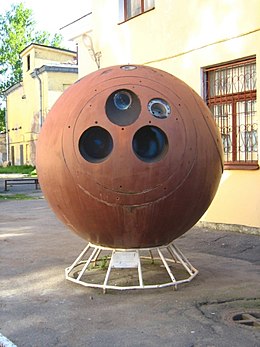 A Zenit reentry capsule | |
| Names | Zenit 2-15 |
|---|---|
| Mission type | Optical imaging reconnaissance |
| Operator | Soviet space program |
| COSPAR ID | 1963-052A |
| SATCAT no. | 712 |
| Mission duration | 9 days |
| Spacecraft properties | |
| Spacecraft type | Zenit-2 |
| Manufacturer | OKB-1 |
| Launch mass | 4730 kg[1] |
| Start of mission | |
| Launch date | 19 December 1963 09:21:00 GMT |
| Rocket | Vostok-2 |
| Launch site | Baikonur 1/5 |
| Contractor | OKB-1 |
| End of mission | |
| Disposal | Recovered |
| Landing date | 28 December 1963 |
| Orbital parameters | |
| Reference system | Geocentric[2] |
| Regime | Low Earth |
| Perigee altitude | 204 km |
| Apogee altitude | 391 km |
| Inclination | 65.0° |
| Period | 90.5 minutes |
| Epoch | 19 December 1963 |
Zenit programme Zenit-2 | |
Kosmos 24 (Russian: Космос 24 meaning Cosmos 24) or Zenit-2 No.15 was a Soviet optical film-return reconnaissance satellite. It was a first generation, low resolution spacecraft. A Zenit-2 satellite, Kosmos 24 was the fifteenth of eighty-one such spacecraft to be launched[3][4] and had a mass of 4,730 kilograms (10,430 lb).
A Vostok-2 rocket, serial number G15001-03,[5] was used to launch Kosmos 24. The launch took place at 09:28:58 UTC on 19 December 1963, from Site 1/5 at the Baikonur Cosmodrome.[6] Following its successful arrival in orbit the spacecraft received its Kosmos designation, along with the International Designator 1963-052A and the Satellite Catalog Number 00712.
Kosmos 24 was operated in a low Earth orbit. On 19 December 1963, it had a perigee of 204 kilometres (127 mi), an apogee of 391 kilometres (243 mi), with inclination of 65.0° and an orbital period of 90.5 minutes.[7] Having spent nine days in orbit, the spacecraft was deorbited on 28 December 1963. Its return capsule descended under parachute for recovery by Soviet forces.
- ^ "NASA - NSSDCA - Spacecraft - Details".
- ^ https://nssdc.gsfc.nasa.gov/nmc/spacecraft/displayTrajectory.action?id=1963-052A - 27 February 2020
- ^ Krebs, Gunter. "Zenit-2 (11F61)". Gunter's Space Page. Archived from the original on 31 December 2011. Retrieved 15 December 2013.
- ^ Wade, Mark. "Zenit-2". Encyclopedia Astronautica. Archived from the original on 23 May 2012. Retrieved 15 December 2013.
- ^ Wade, Mark. "Vostok 8A92". Encyclopedia Astronautica. Archived from the original on 22 August 2016. Retrieved 13 December 2013.
- ^ McDowell, Jonathan. "Launch Log". Jonathan's Space Page. Retrieved 15 December 2013.
- ^ McDowell, Jonathan. "Satellite Catalog". Jonathan's Space Page. Retrieved 15 December 2013.